Midwifery Care: Pethidine Use, Administration, and Potential Risks
VerifiedAdded on 2020/04/01
|10
|2513
|88
Report
AI Summary
This report comprehensively examines the use of Pethidine, also known as Methadone, as a pain relief medication in midwifery care. It details the drug's classification as a synthetic narcotic and opioid analgesic, outlining its indications, contraindications, and necessary precautions during administration. The report explores potential adverse effects such as sedation, hypotension, and interactions with other medications. It further delves into Pethidine's mechanism of action, comparing it to morphine, and discusses its effects on both the mother, including drowsiness and altered perceptions, and the baby, highlighting risks such as respiratory depression and jaundice. The report also covers the midwife's role in administering the drug, dosage considerations, and the importance of monitoring the mother and baby. The study references various research papers to support the findings and emphasizes the declining popularity of Pethidine due to potential complications and the availability of alternative pain management options.
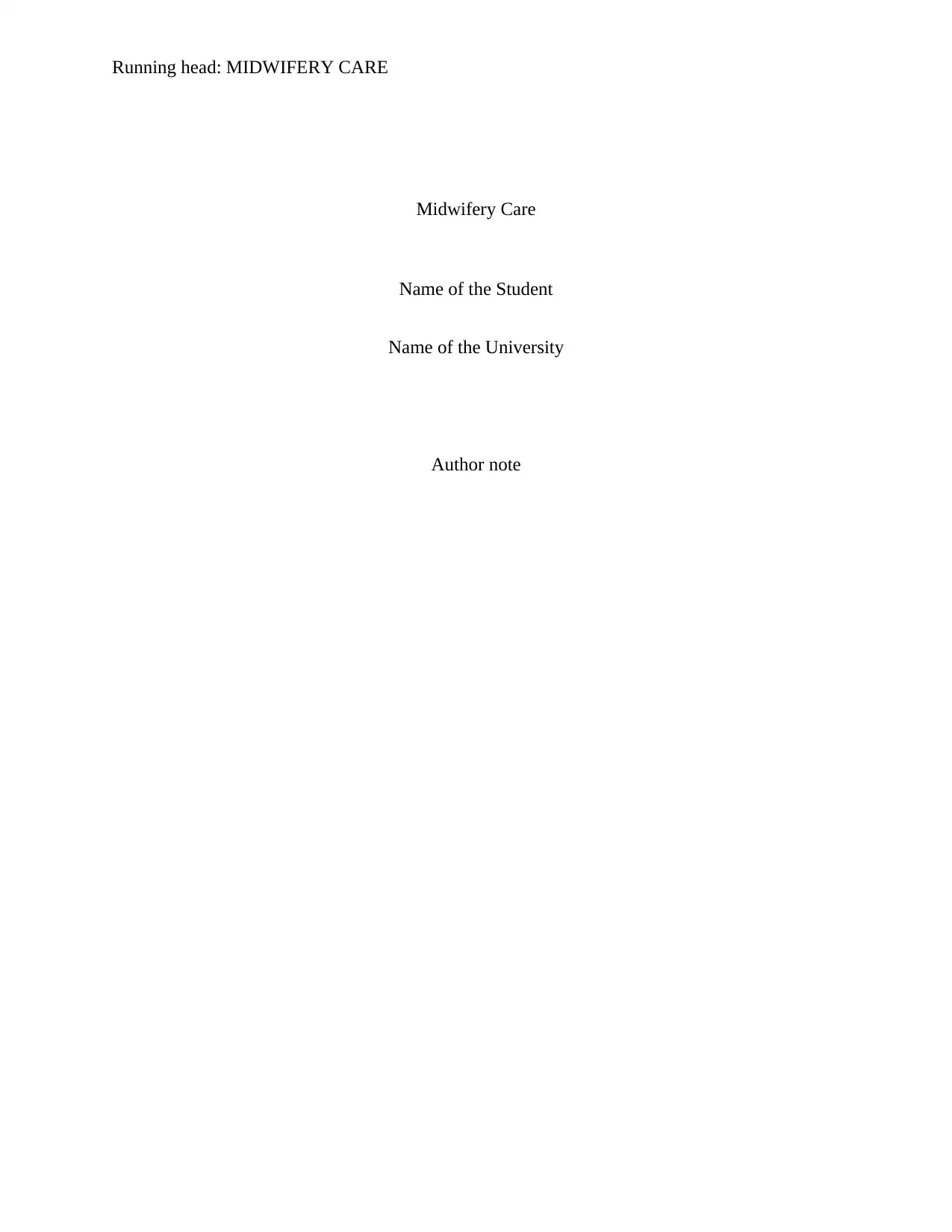
Running head: MIDWIFERY CARE
Midwifery Care
Name of the Student
Name of the University
Author note
Midwifery Care
Name of the Student
Name of the University
Author note
Paraphrase This Document
Need a fresh take? Get an instant paraphrase of this document with our AI Paraphraser
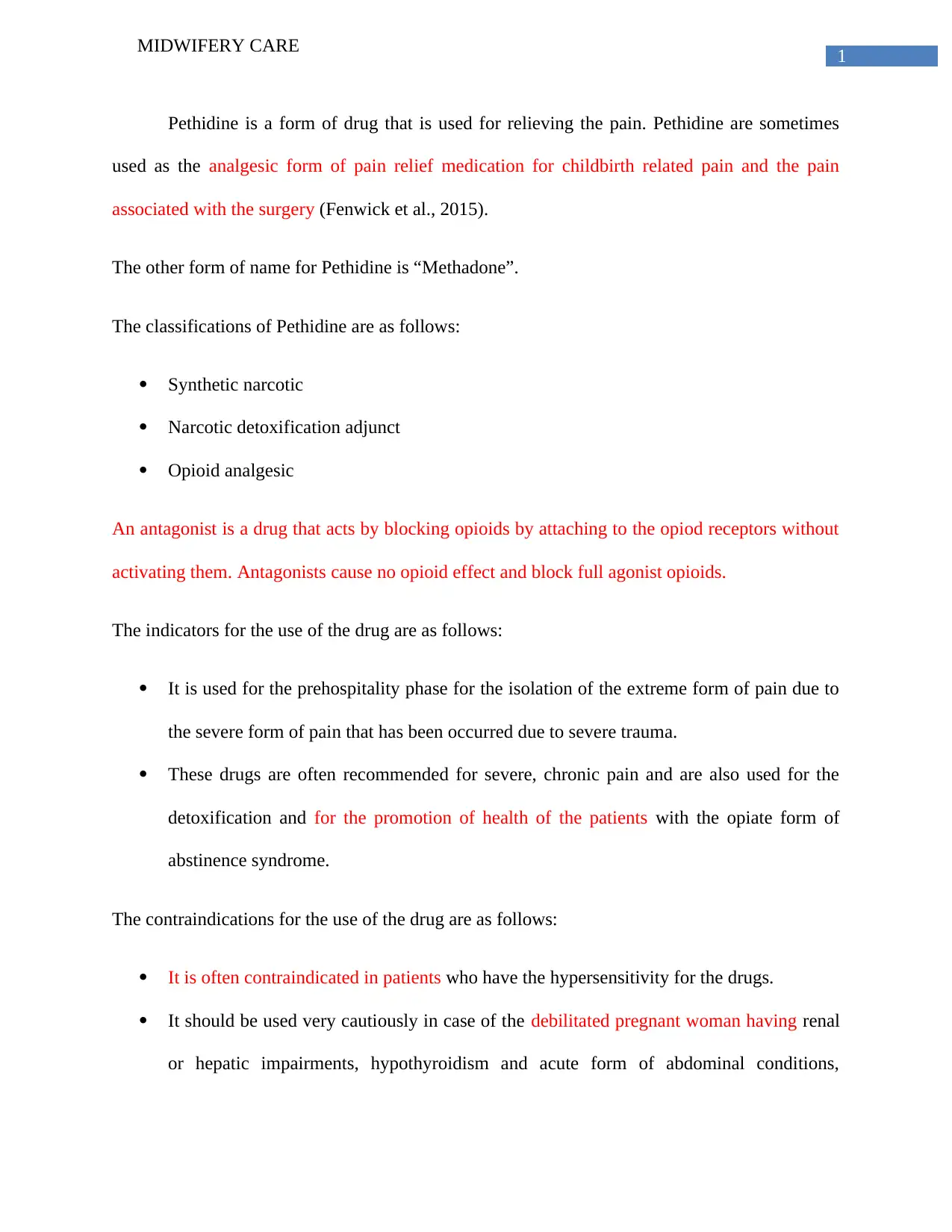
1
MIDWIFERY CARE
Pethidine is a form of drug that is used for relieving the pain. Pethidine are sometimes
used as the analgesic form of pain relief medication for childbirth related pain and the pain
associated with the surgery (Fenwick et al., 2015).
The other form of name for Pethidine is “Methadone”.
The classifications of Pethidine are as follows:
Synthetic narcotic
Narcotic detoxification adjunct
Opioid analgesic
An antagonist is a drug that acts by blocking opioids by attaching to the opiod receptors without
activating them. Antagonists cause no opioid effect and block full agonist opioids.
The indicators for the use of the drug are as follows:
It is used for the prehospitality phase for the isolation of the extreme form of pain due to
the severe form of pain that has been occurred due to severe trauma.
These drugs are often recommended for severe, chronic pain and are also used for the
detoxification and for the promotion of health of the patients with the opiate form of
abstinence syndrome.
The contraindications for the use of the drug are as follows:
It is often contraindicated in patients who have the hypersensitivity for the drugs.
It should be used very cautiously in case of the debilitated pregnant woman having renal
or hepatic impairments, hypothyroidism and acute form of abdominal conditions,
MIDWIFERY CARE
Pethidine is a form of drug that is used for relieving the pain. Pethidine are sometimes
used as the analgesic form of pain relief medication for childbirth related pain and the pain
associated with the surgery (Fenwick et al., 2015).
The other form of name for Pethidine is “Methadone”.
The classifications of Pethidine are as follows:
Synthetic narcotic
Narcotic detoxification adjunct
Opioid analgesic
An antagonist is a drug that acts by blocking opioids by attaching to the opiod receptors without
activating them. Antagonists cause no opioid effect and block full agonist opioids.
The indicators for the use of the drug are as follows:
It is used for the prehospitality phase for the isolation of the extreme form of pain due to
the severe form of pain that has been occurred due to severe trauma.
These drugs are often recommended for severe, chronic pain and are also used for the
detoxification and for the promotion of health of the patients with the opiate form of
abstinence syndrome.
The contraindications for the use of the drug are as follows:
It is often contraindicated in patients who have the hypersensitivity for the drugs.
It should be used very cautiously in case of the debilitated pregnant woman having renal
or hepatic impairments, hypothyroidism and acute form of abdominal conditions,
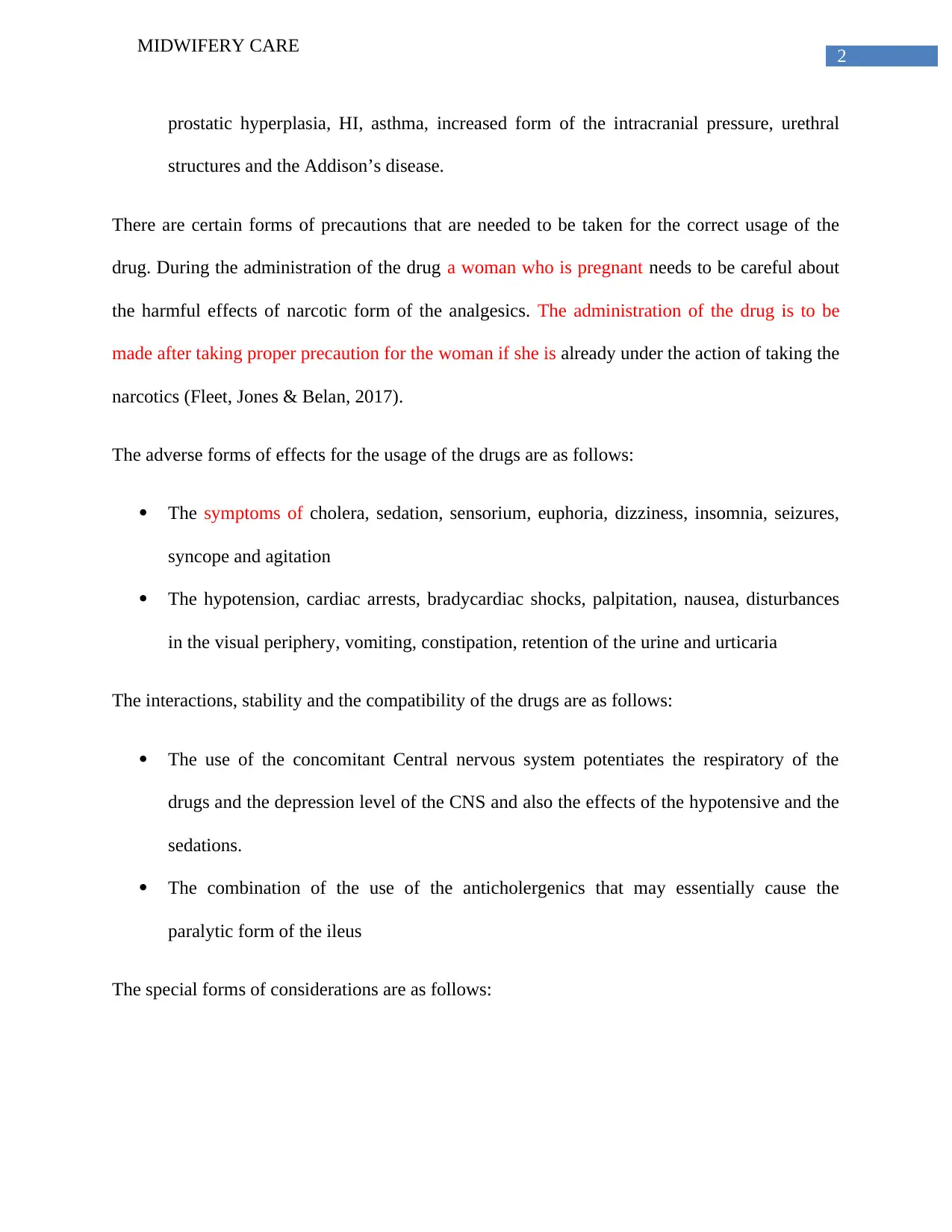
2
MIDWIFERY CARE
prostatic hyperplasia, HI, asthma, increased form of the intracranial pressure, urethral
structures and the Addison’s disease.
There are certain forms of precautions that are needed to be taken for the correct usage of the
drug. During the administration of the drug a woman who is pregnant needs to be careful about
the harmful effects of narcotic form of the analgesics. The administration of the drug is to be
made after taking proper precaution for the woman if she is already under the action of taking the
narcotics (Fleet, Jones & Belan, 2017).
The adverse forms of effects for the usage of the drugs are as follows:
The symptoms of cholera, sedation, sensorium, euphoria, dizziness, insomnia, seizures,
syncope and agitation
The hypotension, cardiac arrests, bradycardiac shocks, palpitation, nausea, disturbances
in the visual periphery, vomiting, constipation, retention of the urine and urticaria
The interactions, stability and the compatibility of the drugs are as follows:
The use of the concomitant Central nervous system potentiates the respiratory of the
drugs and the depression level of the CNS and also the effects of the hypotensive and the
sedations.
The combination of the use of the anticholergenics that may essentially cause the
paralytic form of the ileus
The special forms of considerations are as follows:
MIDWIFERY CARE
prostatic hyperplasia, HI, asthma, increased form of the intracranial pressure, urethral
structures and the Addison’s disease.
There are certain forms of precautions that are needed to be taken for the correct usage of the
drug. During the administration of the drug a woman who is pregnant needs to be careful about
the harmful effects of narcotic form of the analgesics. The administration of the drug is to be
made after taking proper precaution for the woman if she is already under the action of taking the
narcotics (Fleet, Jones & Belan, 2017).
The adverse forms of effects for the usage of the drugs are as follows:
The symptoms of cholera, sedation, sensorium, euphoria, dizziness, insomnia, seizures,
syncope and agitation
The hypotension, cardiac arrests, bradycardiac shocks, palpitation, nausea, disturbances
in the visual periphery, vomiting, constipation, retention of the urine and urticaria
The interactions, stability and the compatibility of the drugs are as follows:
The use of the concomitant Central nervous system potentiates the respiratory of the
drugs and the depression level of the CNS and also the effects of the hypotensive and the
sedations.
The combination of the use of the anticholergenics that may essentially cause the
paralytic form of the ileus
The special forms of considerations are as follows:
⊘ This is a preview!⊘
Do you want full access?
Subscribe today to unlock all pages.

Trusted by 1+ million students worldwide
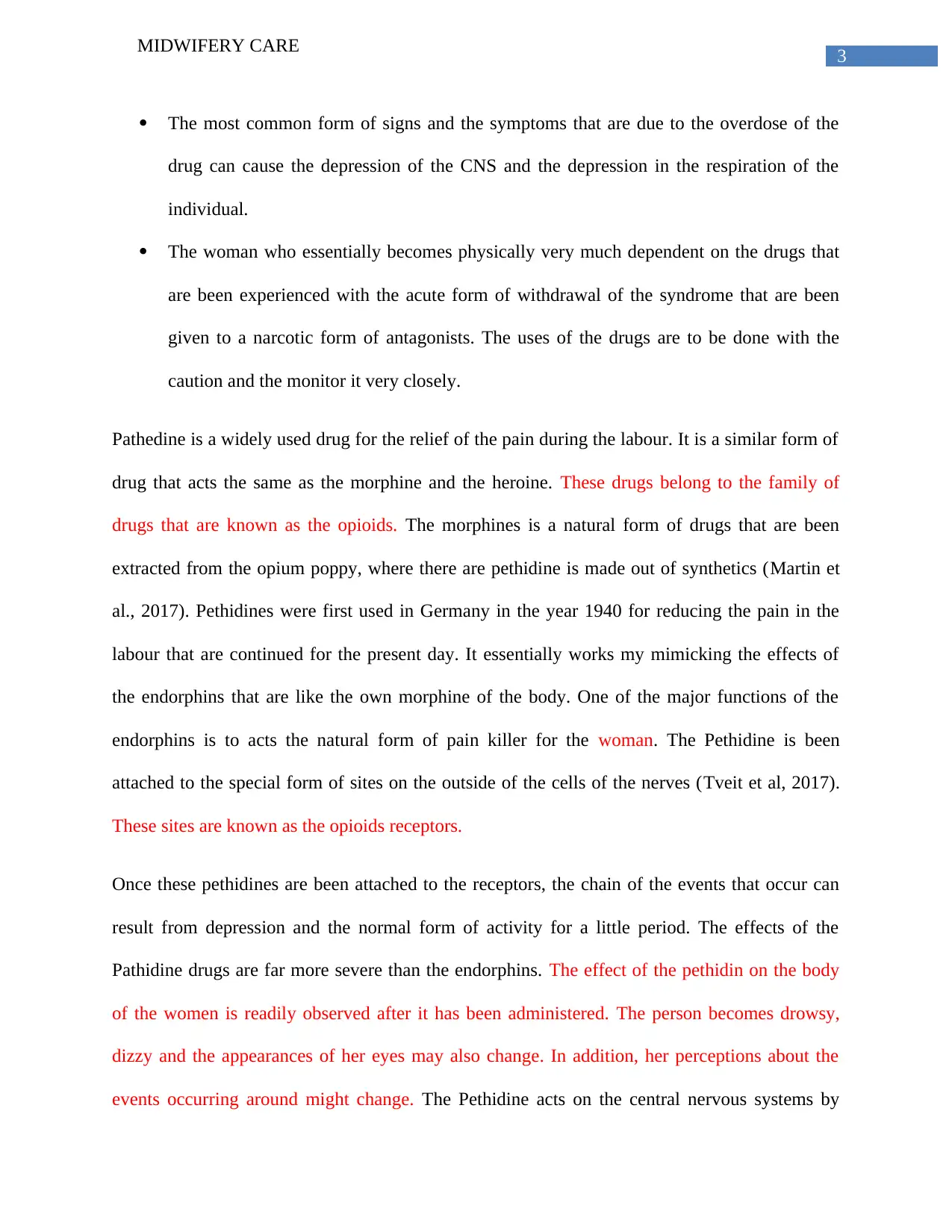
3
MIDWIFERY CARE
The most common form of signs and the symptoms that are due to the overdose of the
drug can cause the depression of the CNS and the depression in the respiration of the
individual.
The woman who essentially becomes physically very much dependent on the drugs that
are been experienced with the acute form of withdrawal of the syndrome that are been
given to a narcotic form of antagonists. The uses of the drugs are to be done with the
caution and the monitor it very closely.
Pathedine is a widely used drug for the relief of the pain during the labour. It is a similar form of
drug that acts the same as the morphine and the heroine. These drugs belong to the family of
drugs that are known as the opioids. The morphines is a natural form of drugs that are been
extracted from the opium poppy, where there are pethidine is made out of synthetics (Martin et
al., 2017). Pethidines were first used in Germany in the year 1940 for reducing the pain in the
labour that are continued for the present day. It essentially works my mimicking the effects of
the endorphins that are like the own morphine of the body. One of the major functions of the
endorphins is to acts the natural form of pain killer for the woman. The Pethidine is been
attached to the special form of sites on the outside of the cells of the nerves (Tveit et al, 2017).
These sites are known as the opioids receptors.
Once these pethidines are been attached to the receptors, the chain of the events that occur can
result from depression and the normal form of activity for a little period. The effects of the
Pathidine drugs are far more severe than the endorphins. The effect of the pethidin on the body
of the women is readily observed after it has been administered. The person becomes drowsy,
dizzy and the appearances of her eyes may also change. In addition, her perceptions about the
events occurring around might change. The Pethidine acts on the central nervous systems by
MIDWIFERY CARE
The most common form of signs and the symptoms that are due to the overdose of the
drug can cause the depression of the CNS and the depression in the respiration of the
individual.
The woman who essentially becomes physically very much dependent on the drugs that
are been experienced with the acute form of withdrawal of the syndrome that are been
given to a narcotic form of antagonists. The uses of the drugs are to be done with the
caution and the monitor it very closely.
Pathedine is a widely used drug for the relief of the pain during the labour. It is a similar form of
drug that acts the same as the morphine and the heroine. These drugs belong to the family of
drugs that are known as the opioids. The morphines is a natural form of drugs that are been
extracted from the opium poppy, where there are pethidine is made out of synthetics (Martin et
al., 2017). Pethidines were first used in Germany in the year 1940 for reducing the pain in the
labour that are continued for the present day. It essentially works my mimicking the effects of
the endorphins that are like the own morphine of the body. One of the major functions of the
endorphins is to acts the natural form of pain killer for the woman. The Pethidine is been
attached to the special form of sites on the outside of the cells of the nerves (Tveit et al, 2017).
These sites are known as the opioids receptors.
Once these pethidines are been attached to the receptors, the chain of the events that occur can
result from depression and the normal form of activity for a little period. The effects of the
Pathidine drugs are far more severe than the endorphins. The effect of the pethidin on the body
of the women is readily observed after it has been administered. The person becomes drowsy,
dizzy and the appearances of her eyes may also change. In addition, her perceptions about the
events occurring around might change. The Pethidine acts on the central nervous systems by
Paraphrase This Document
Need a fresh take? Get an instant paraphrase of this document with our AI Paraphraser
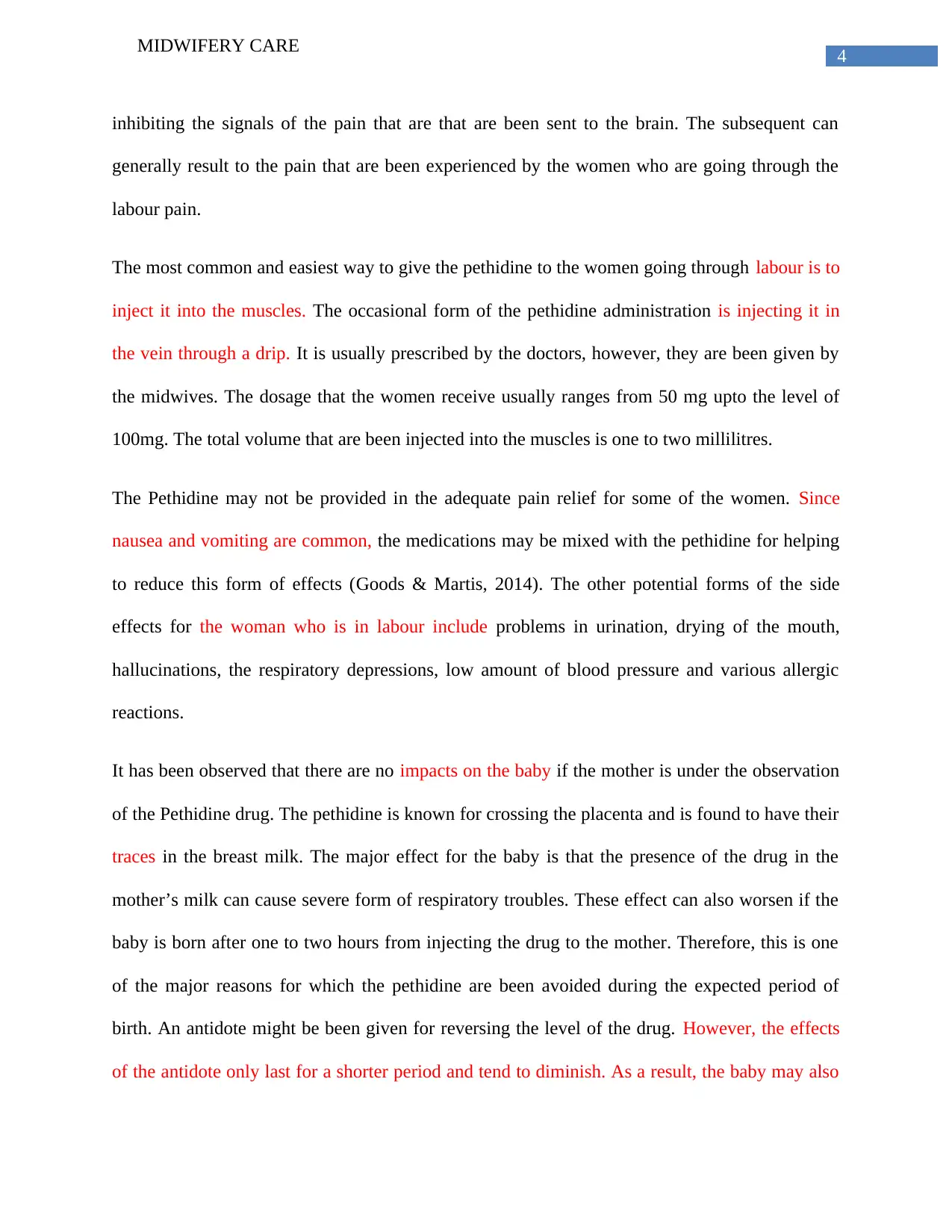
4
MIDWIFERY CARE
inhibiting the signals of the pain that are that are been sent to the brain. The subsequent can
generally result to the pain that are been experienced by the women who are going through the
labour pain.
The most common and easiest way to give the pethidine to the women going through labour is to
inject it into the muscles. The occasional form of the pethidine administration is injecting it in
the vein through a drip. It is usually prescribed by the doctors, however, they are been given by
the midwives. The dosage that the women receive usually ranges from 50 mg upto the level of
100mg. The total volume that are been injected into the muscles is one to two millilitres.
The Pethidine may not be provided in the adequate pain relief for some of the women. Since
nausea and vomiting are common, the medications may be mixed with the pethidine for helping
to reduce this form of effects (Goods & Martis, 2014). The other potential forms of the side
effects for the woman who is in labour include problems in urination, drying of the mouth,
hallucinations, the respiratory depressions, low amount of blood pressure and various allergic
reactions.
It has been observed that there are no impacts on the baby if the mother is under the observation
of the Pethidine drug. The pethidine is known for crossing the placenta and is found to have their
traces in the breast milk. The major effect for the baby is that the presence of the drug in the
mother’s milk can cause severe form of respiratory troubles. These effect can also worsen if the
baby is born after one to two hours from injecting the drug to the mother. Therefore, this is one
of the major reasons for which the pethidine are been avoided during the expected period of
birth. An antidote might be been given for reversing the level of the drug. However, the effects
of the antidote only last for a shorter period and tend to diminish. As a result, the baby may also
MIDWIFERY CARE
inhibiting the signals of the pain that are that are been sent to the brain. The subsequent can
generally result to the pain that are been experienced by the women who are going through the
labour pain.
The most common and easiest way to give the pethidine to the women going through labour is to
inject it into the muscles. The occasional form of the pethidine administration is injecting it in
the vein through a drip. It is usually prescribed by the doctors, however, they are been given by
the midwives. The dosage that the women receive usually ranges from 50 mg upto the level of
100mg. The total volume that are been injected into the muscles is one to two millilitres.
The Pethidine may not be provided in the adequate pain relief for some of the women. Since
nausea and vomiting are common, the medications may be mixed with the pethidine for helping
to reduce this form of effects (Goods & Martis, 2014). The other potential forms of the side
effects for the woman who is in labour include problems in urination, drying of the mouth,
hallucinations, the respiratory depressions, low amount of blood pressure and various allergic
reactions.
It has been observed that there are no impacts on the baby if the mother is under the observation
of the Pethidine drug. The pethidine is known for crossing the placenta and is found to have their
traces in the breast milk. The major effect for the baby is that the presence of the drug in the
mother’s milk can cause severe form of respiratory troubles. These effect can also worsen if the
baby is born after one to two hours from injecting the drug to the mother. Therefore, this is one
of the major reasons for which the pethidine are been avoided during the expected period of
birth. An antidote might be been given for reversing the level of the drug. However, the effects
of the antidote only last for a shorter period and tend to diminish. As a result, the baby may also
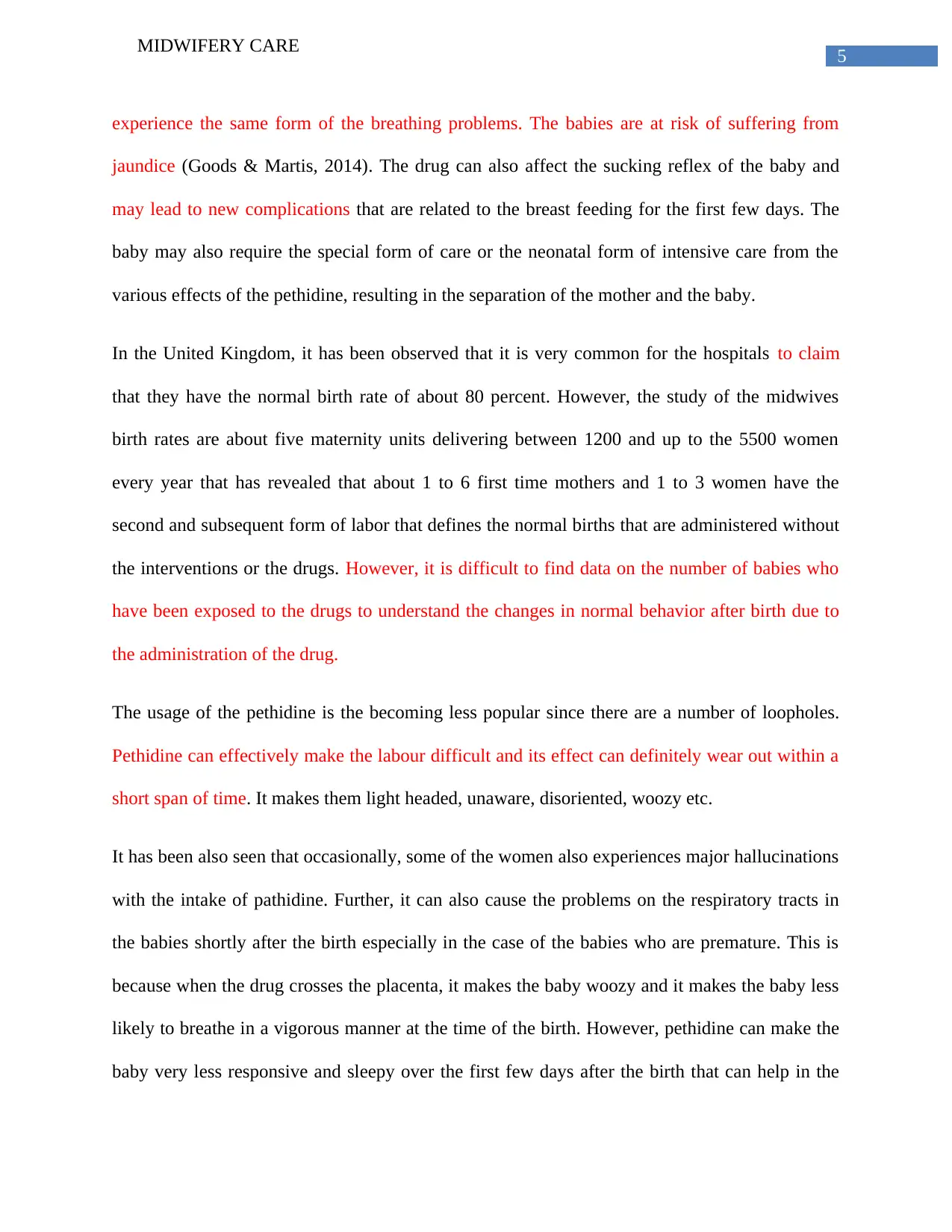
5
MIDWIFERY CARE
experience the same form of the breathing problems. The babies are at risk of suffering from
jaundice (Goods & Martis, 2014). The drug can also affect the sucking reflex of the baby and
may lead to new complications that are related to the breast feeding for the first few days. The
baby may also require the special form of care or the neonatal form of intensive care from the
various effects of the pethidine, resulting in the separation of the mother and the baby.
In the United Kingdom, it has been observed that it is very common for the hospitals to claim
that they have the normal birth rate of about 80 percent. However, the study of the midwives
birth rates are about five maternity units delivering between 1200 and up to the 5500 women
every year that has revealed that about 1 to 6 first time mothers and 1 to 3 women have the
second and subsequent form of labor that defines the normal births that are administered without
the interventions or the drugs. However, it is difficult to find data on the number of babies who
have been exposed to the drugs to understand the changes in normal behavior after birth due to
the administration of the drug.
The usage of the pethidine is the becoming less popular since there are a number of loopholes.
Pethidine can effectively make the labour difficult and its effect can definitely wear out within a
short span of time. It makes them light headed, unaware, disoriented, woozy etc.
It has been also seen that occasionally, some of the women also experiences major hallucinations
with the intake of pathidine. Further, it can also cause the problems on the respiratory tracts in
the babies shortly after the birth especially in the case of the babies who are premature. This is
because when the drug crosses the placenta, it makes the baby woozy and it makes the baby less
likely to breathe in a vigorous manner at the time of the birth. However, pethidine can make the
baby very less responsive and sleepy over the first few days after the birth that can help in the
MIDWIFERY CARE
experience the same form of the breathing problems. The babies are at risk of suffering from
jaundice (Goods & Martis, 2014). The drug can also affect the sucking reflex of the baby and
may lead to new complications that are related to the breast feeding for the first few days. The
baby may also require the special form of care or the neonatal form of intensive care from the
various effects of the pethidine, resulting in the separation of the mother and the baby.
In the United Kingdom, it has been observed that it is very common for the hospitals to claim
that they have the normal birth rate of about 80 percent. However, the study of the midwives
birth rates are about five maternity units delivering between 1200 and up to the 5500 women
every year that has revealed that about 1 to 6 first time mothers and 1 to 3 women have the
second and subsequent form of labor that defines the normal births that are administered without
the interventions or the drugs. However, it is difficult to find data on the number of babies who
have been exposed to the drugs to understand the changes in normal behavior after birth due to
the administration of the drug.
The usage of the pethidine is the becoming less popular since there are a number of loopholes.
Pethidine can effectively make the labour difficult and its effect can definitely wear out within a
short span of time. It makes them light headed, unaware, disoriented, woozy etc.
It has been also seen that occasionally, some of the women also experiences major hallucinations
with the intake of pathidine. Further, it can also cause the problems on the respiratory tracts in
the babies shortly after the birth especially in the case of the babies who are premature. This is
because when the drug crosses the placenta, it makes the baby woozy and it makes the baby less
likely to breathe in a vigorous manner at the time of the birth. However, pethidine can make the
baby very less responsive and sleepy over the first few days after the birth that can help in the
⊘ This is a preview!⊘
Do you want full access?
Subscribe today to unlock all pages.

Trusted by 1+ million students worldwide
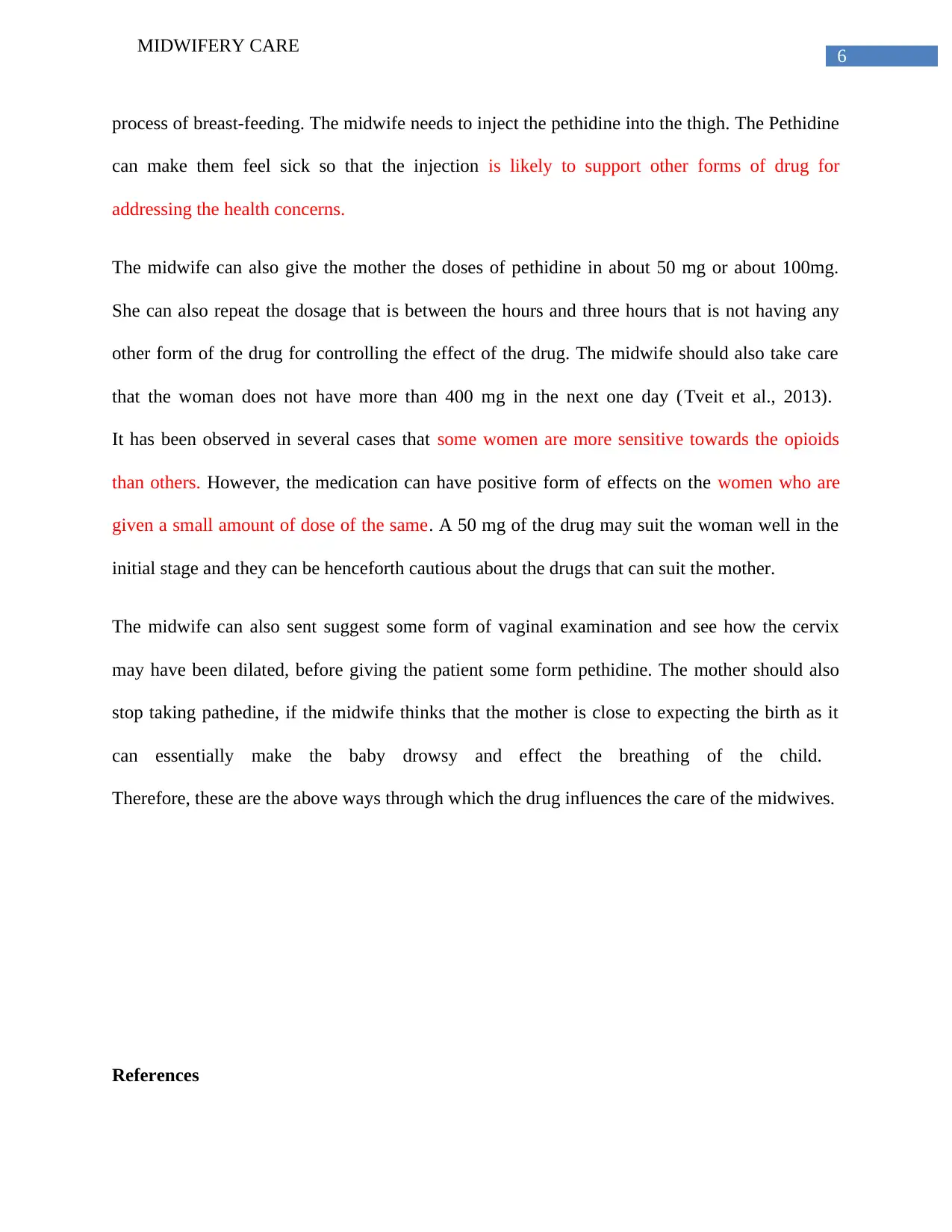
6
MIDWIFERY CARE
process of breast-feeding. The midwife needs to inject the pethidine into the thigh. The Pethidine
can make them feel sick so that the injection is likely to support other forms of drug for
addressing the health concerns.
The midwife can also give the mother the doses of pethidine in about 50 mg or about 100mg.
She can also repeat the dosage that is between the hours and three hours that is not having any
other form of the drug for controlling the effect of the drug. The midwife should also take care
that the woman does not have more than 400 mg in the next one day (Tveit et al., 2013).
It has been observed in several cases that some women are more sensitive towards the opioids
than others. However, the medication can have positive form of effects on the women who are
given a small amount of dose of the same. A 50 mg of the drug may suit the woman well in the
initial stage and they can be henceforth cautious about the drugs that can suit the mother.
The midwife can also sent suggest some form of vaginal examination and see how the cervix
may have been dilated, before giving the patient some form pethidine. The mother should also
stop taking pathedine, if the midwife thinks that the mother is close to expecting the birth as it
can essentially make the baby drowsy and effect the breathing of the child.
Therefore, these are the above ways through which the drug influences the care of the midwives.
References
MIDWIFERY CARE
process of breast-feeding. The midwife needs to inject the pethidine into the thigh. The Pethidine
can make them feel sick so that the injection is likely to support other forms of drug for
addressing the health concerns.
The midwife can also give the mother the doses of pethidine in about 50 mg or about 100mg.
She can also repeat the dosage that is between the hours and three hours that is not having any
other form of the drug for controlling the effect of the drug. The midwife should also take care
that the woman does not have more than 400 mg in the next one day (Tveit et al., 2013).
It has been observed in several cases that some women are more sensitive towards the opioids
than others. However, the medication can have positive form of effects on the women who are
given a small amount of dose of the same. A 50 mg of the drug may suit the woman well in the
initial stage and they can be henceforth cautious about the drugs that can suit the mother.
The midwife can also sent suggest some form of vaginal examination and see how the cervix
may have been dilated, before giving the patient some form pethidine. The mother should also
stop taking pathedine, if the midwife thinks that the mother is close to expecting the birth as it
can essentially make the baby drowsy and effect the breathing of the child.
Therefore, these are the above ways through which the drug influences the care of the midwives.
References
Paraphrase This Document
Need a fresh take? Get an instant paraphrase of this document with our AI Paraphraser
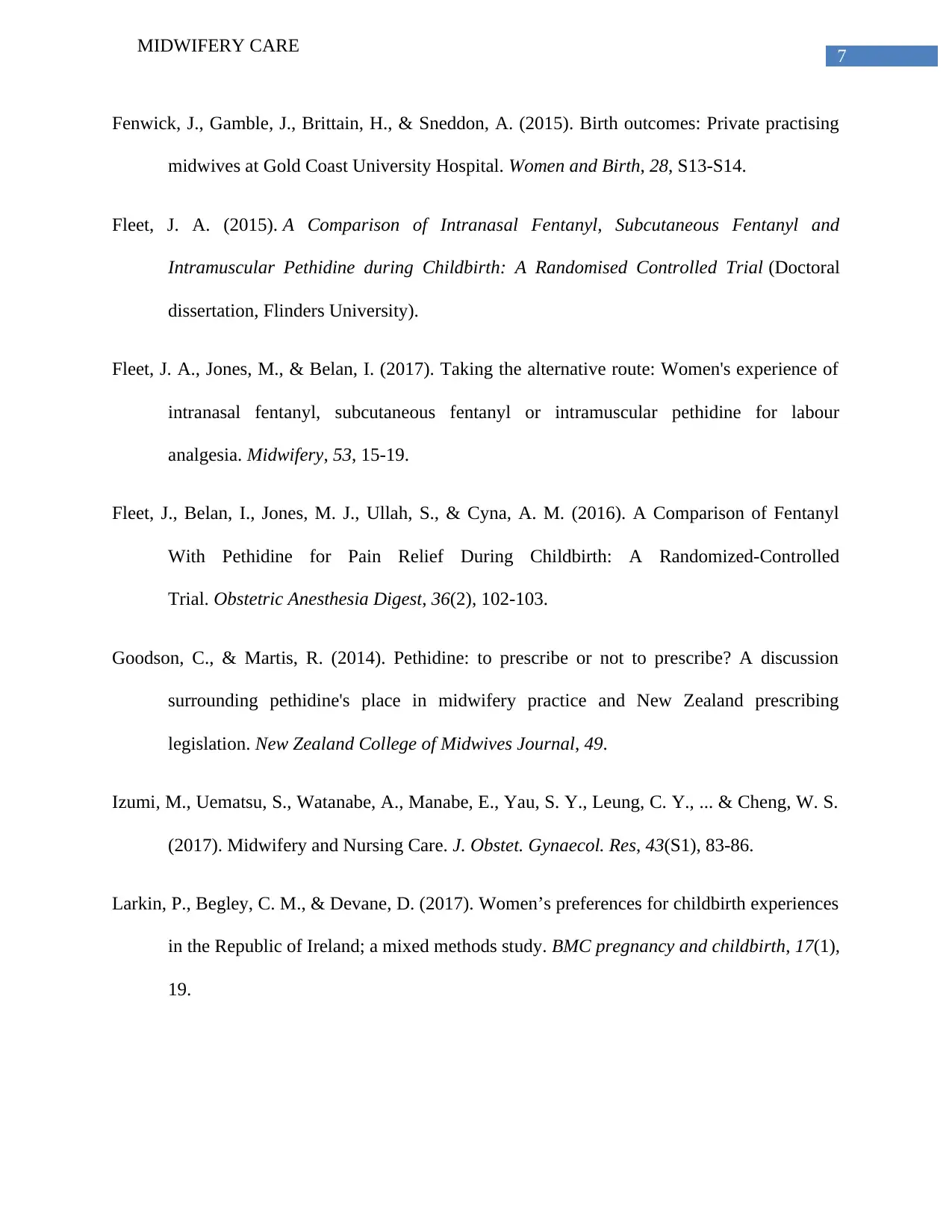
7
MIDWIFERY CARE
Fenwick, J., Gamble, J., Brittain, H., & Sneddon, A. (2015). Birth outcomes: Private practising
midwives at Gold Coast University Hospital. Women and Birth, 28, S13-S14.
Fleet, J. A. (2015). A Comparison of Intranasal Fentanyl, Subcutaneous Fentanyl and
Intramuscular Pethidine during Childbirth: A Randomised Controlled Trial (Doctoral
dissertation, Flinders University).
Fleet, J. A., Jones, M., & Belan, I. (2017). Taking the alternative route: Women's experience of
intranasal fentanyl, subcutaneous fentanyl or intramuscular pethidine for labour
analgesia. Midwifery, 53, 15-19.
Fleet, J., Belan, I., Jones, M. J., Ullah, S., & Cyna, A. M. (2016). A Comparison of Fentanyl
With Pethidine for Pain Relief During Childbirth: A Randomized-Controlled
Trial. Obstetric Anesthesia Digest, 36(2), 102-103.
Goodson, C., & Martis, R. (2014). Pethidine: to prescribe or not to prescribe? A discussion
surrounding pethidine's place in midwifery practice and New Zealand prescribing
legislation. New Zealand College of Midwives Journal, 49.
Izumi, M., Uematsu, S., Watanabe, A., Manabe, E., Yau, S. Y., Leung, C. Y., ... & Cheng, W. S.
(2017). Midwifery and Nursing Care. J. Obstet. Gynaecol. Res, 43(S1), 83-86.
Larkin, P., Begley, C. M., & Devane, D. (2017). Women’s preferences for childbirth experiences
in the Republic of Ireland; a mixed methods study. BMC pregnancy and childbirth, 17(1),
19.
MIDWIFERY CARE
Fenwick, J., Gamble, J., Brittain, H., & Sneddon, A. (2015). Birth outcomes: Private practising
midwives at Gold Coast University Hospital. Women and Birth, 28, S13-S14.
Fleet, J. A. (2015). A Comparison of Intranasal Fentanyl, Subcutaneous Fentanyl and
Intramuscular Pethidine during Childbirth: A Randomised Controlled Trial (Doctoral
dissertation, Flinders University).
Fleet, J. A., Jones, M., & Belan, I. (2017). Taking the alternative route: Women's experience of
intranasal fentanyl, subcutaneous fentanyl or intramuscular pethidine for labour
analgesia. Midwifery, 53, 15-19.
Fleet, J., Belan, I., Jones, M. J., Ullah, S., & Cyna, A. M. (2016). A Comparison of Fentanyl
With Pethidine for Pain Relief During Childbirth: A Randomized-Controlled
Trial. Obstetric Anesthesia Digest, 36(2), 102-103.
Goodson, C., & Martis, R. (2014). Pethidine: to prescribe or not to prescribe? A discussion
surrounding pethidine's place in midwifery practice and New Zealand prescribing
legislation. New Zealand College of Midwives Journal, 49.
Izumi, M., Uematsu, S., Watanabe, A., Manabe, E., Yau, S. Y., Leung, C. Y., ... & Cheng, W. S.
(2017). Midwifery and Nursing Care. J. Obstet. Gynaecol. Res, 43(S1), 83-86.
Larkin, P., Begley, C. M., & Devane, D. (2017). Women’s preferences for childbirth experiences
in the Republic of Ireland; a mixed methods study. BMC pregnancy and childbirth, 17(1),
19.
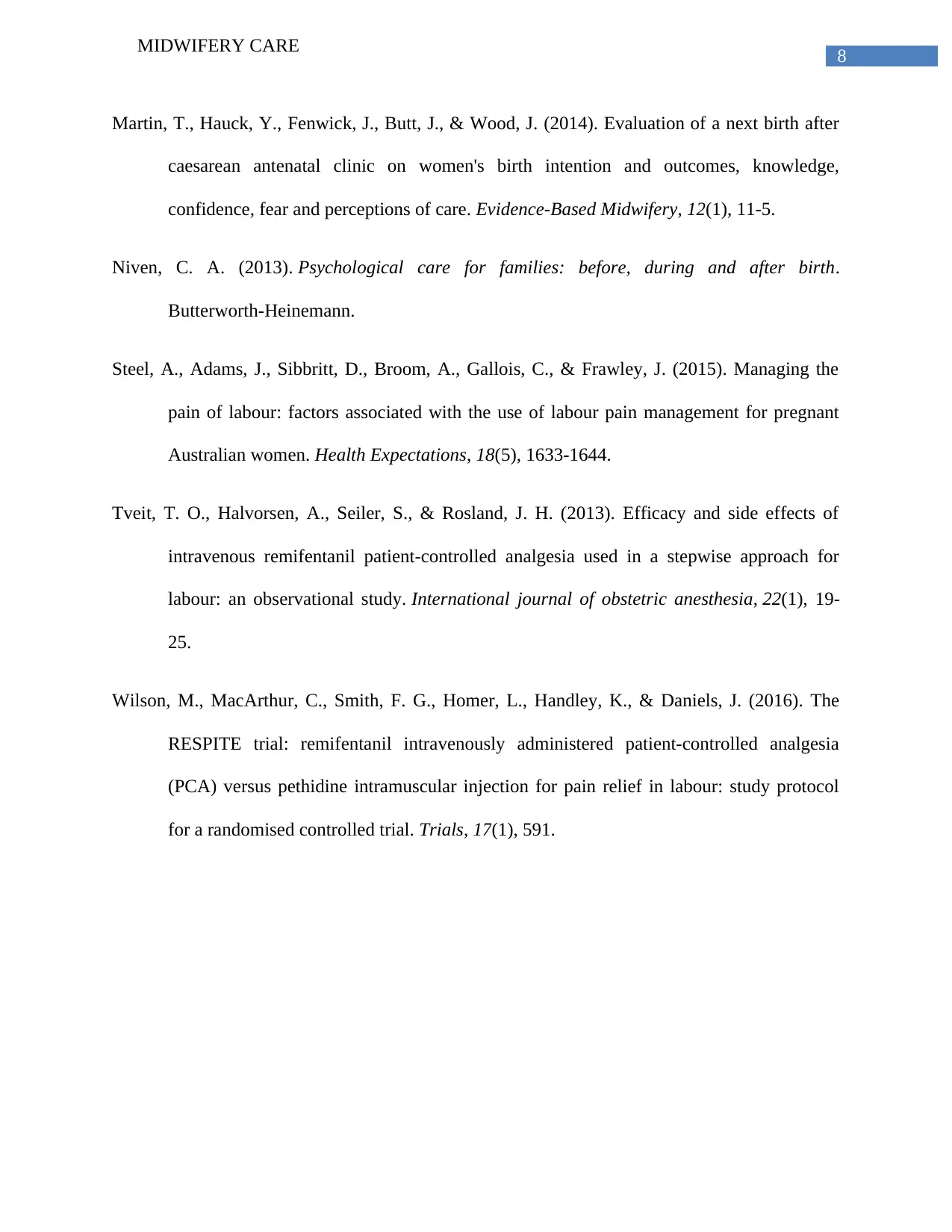
8
MIDWIFERY CARE
Martin, T., Hauck, Y., Fenwick, J., Butt, J., & Wood, J. (2014). Evaluation of a next birth after
caesarean antenatal clinic on women's birth intention and outcomes, knowledge,
confidence, fear and perceptions of care. Evidence-Based Midwifery, 12(1), 11-5.
Niven, C. A. (2013). Psychological care for families: before, during and after birth.
Butterworth-Heinemann.
Steel, A., Adams, J., Sibbritt, D., Broom, A., Gallois, C., & Frawley, J. (2015). Managing the
pain of labour: factors associated with the use of labour pain management for pregnant
Australian women. Health Expectations, 18(5), 1633-1644.
Tveit, T. O., Halvorsen, A., Seiler, S., & Rosland, J. H. (2013). Efficacy and side effects of
intravenous remifentanil patient-controlled analgesia used in a stepwise approach for
labour: an observational study. International journal of obstetric anesthesia, 22(1), 19-
25.
Wilson, M., MacArthur, C., Smith, F. G., Homer, L., Handley, K., & Daniels, J. (2016). The
RESPITE trial: remifentanil intravenously administered patient-controlled analgesia
(PCA) versus pethidine intramuscular injection for pain relief in labour: study protocol
for a randomised controlled trial. Trials, 17(1), 591.
MIDWIFERY CARE
Martin, T., Hauck, Y., Fenwick, J., Butt, J., & Wood, J. (2014). Evaluation of a next birth after
caesarean antenatal clinic on women's birth intention and outcomes, knowledge,
confidence, fear and perceptions of care. Evidence-Based Midwifery, 12(1), 11-5.
Niven, C. A. (2013). Psychological care for families: before, during and after birth.
Butterworth-Heinemann.
Steel, A., Adams, J., Sibbritt, D., Broom, A., Gallois, C., & Frawley, J. (2015). Managing the
pain of labour: factors associated with the use of labour pain management for pregnant
Australian women. Health Expectations, 18(5), 1633-1644.
Tveit, T. O., Halvorsen, A., Seiler, S., & Rosland, J. H. (2013). Efficacy and side effects of
intravenous remifentanil patient-controlled analgesia used in a stepwise approach for
labour: an observational study. International journal of obstetric anesthesia, 22(1), 19-
25.
Wilson, M., MacArthur, C., Smith, F. G., Homer, L., Handley, K., & Daniels, J. (2016). The
RESPITE trial: remifentanil intravenously administered patient-controlled analgesia
(PCA) versus pethidine intramuscular injection for pain relief in labour: study protocol
for a randomised controlled trial. Trials, 17(1), 591.
⊘ This is a preview!⊘
Do you want full access?
Subscribe today to unlock all pages.

Trusted by 1+ million students worldwide

9
MIDWIFERY CARE
MIDWIFERY CARE
1 out of 10
Your All-in-One AI-Powered Toolkit for Academic Success.
+13062052269
info@desklib.com
Available 24*7 on WhatsApp / Email
![[object Object]](/_next/static/media/star-bottom.7253800d.svg)
Unlock your academic potential
Copyright © 2020–2025 A2Z Services. All Rights Reserved. Developed and managed by ZUCOL.
